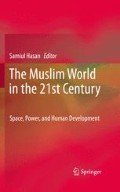Abstract
This chapter presents descriptive and comparative analyses of current urbanization patterns in the Muslim majority countries (MMCs), and highlights the state of infrastructure in the MMCs’ urban areas. The major discussion in the chapter relates the patterns of urbanization, and the infrastructure gap to geography and historical past of the MMCs. It prepares a composite infrastructure access index (IAI) to conclude that the large IAI scores in many countries are likely to eventually neutralize the economic benefits achieved by urban infrastructure. The chapter comments that planned measures need to be undertaken in the MMCs for the provision of transportation, water, and sanitation to improve the living conditions in both high- and low-density areas to stop transmigration between the two and to create better environment for human development.
Access this chapter
Tax calculation will be finalised at checkout
Purchases are for personal use only
Notes
- 1.
For example, a very high percentage of population (70–80%) in the working age group (15–64) in Bahrain, Brunei, Iran, Kuwait, Qatar, or UAE is a testament to these countries’ dependents on expatriate workers (for more see Chap. 16 in this Volume).
- 2.
A recent report from the United Nations Center for Human Settlement states that the most challenging form of urbanization in the future will be faced by Africa and Asia.
- 3.
Please see Chap. 1 in this Volume for an explanation and listing of the MMCs.
- 4.
The figures look different because while the number of Muslim population in a country is available that in urban areas is not. Thus, population numbers in urban areas include non-Muslims.
- 5.
According to Ibn Khaldun if the North/South axis (0–63°) is equally divided in seven zones (with 9° Latitude each), the (old) world civilizations were most developed in Zone 4 (28° and 36°N; Lacoste 1984). Zones in this chapter are divided on that basis (for more see Chap. 1 in this Volume).
- 6.
Road density in Bangladesh, a predominantly rural country, is 166, but about 10% of the roads is paved (Table 12.8).
- 7.
For example, as explained in the Human Development Report 2006, in Egypt “high levels of pollution from raw sewage in the Nile Delta region” “undermines the potential health benefits of near universal access to water” (cited in UNDP 2009a, p. 45).
- 8.
Access to sanitation is defined by the existence of sanitary latrine within the living area; and access to water is defined by availability of running water within 500 m of the living area.
- 9.
An urban rural parity situation (99% no access for both sanitation and water and only a possible 1% gaps in both between rural and urban areas) and an urban biased situation (a 0% no access in urban areas for both sanitation and water and 1% access in both in rural areas) both will create the worst IAI of 100.
- 10.
Since all data are not available, six MMCs Bahrain, Iran, Libya, Oman, Saudi Arabia, and Turkmenistan are not included in the analysis.
- 11.
It seems the IAI scores in the two MMCs of higher Latitude (Azerbaijan due to a lower access to water, and Morocco due to a lower access to sanitation) also defy the pattern.
- 12.
For example, Chap. 1 in this Volume discusses the possible impacts in West Asia (Qatar, Saudi Arabia, and UAE) with the largest percentage of expatriate population in the region that creates a male/female ratio of 245/100, 128/100, and 276/100, respectively in the 15–64 age group.
References
El Jaouhari, A. (2004). Urban primacy and the role of trade openness. Doctoral dissertation, Cleveland State University.
Lacoste, Y. (1984). Ibn Khaldun: The Birth of History and the Past of the Third World. London: Verso.
Levy, J. M. (2008). Contemporary urban planning (6th ed.). Upper Saddle River: Prentice-Hall.
UNDP. (2009a). Arab Human Development Report 2009. www.undp.org.
UNDP. (2009b). Human Development Report 2009. www.undp.org.
United Nations. (2009). World urbanization prospects (WUP): The 2007 revision. New York: UN Department of Economic and Social Information and Policy Analysis.
Author information
Authors and Affiliations
Corresponding author
Editor information
Editors and Affiliations
Rights and permissions
Copyright information
© 2012 Springer Science+Business Media B.V.
About this chapter
Cite this chapter
Jaouhari, A., Hasan, S. (2012). Urban Infrastructure in the Muslim Majority Countries: A Situational Analysis. In: Hasan, S. (eds) The Muslim World in the 21st Century. Springer, Dordrecht. https://doi.org/10.1007/978-94-007-2633-8_12
Download citation
DOI: https://doi.org/10.1007/978-94-007-2633-8_12
Published:
Publisher Name: Springer, Dordrecht
Print ISBN: 978-94-007-2632-1
Online ISBN: 978-94-007-2633-8
eBook Packages: Humanities, Social Sciences and LawSocial Sciences (R0)

